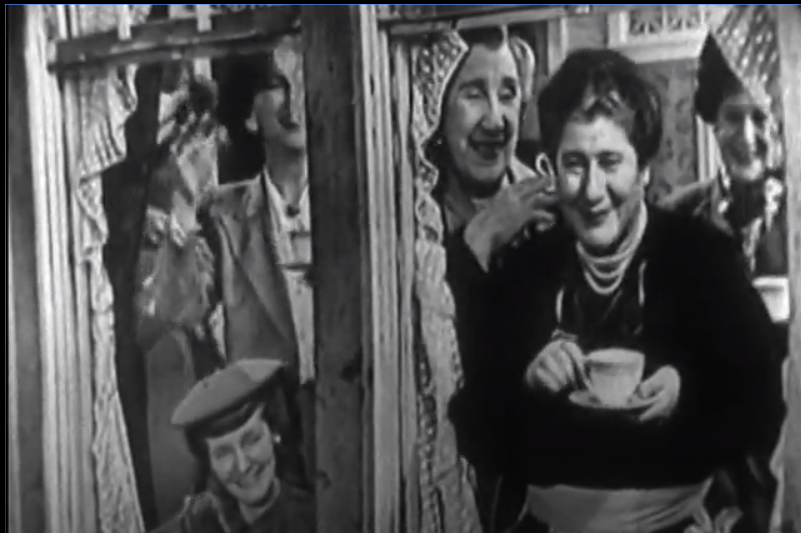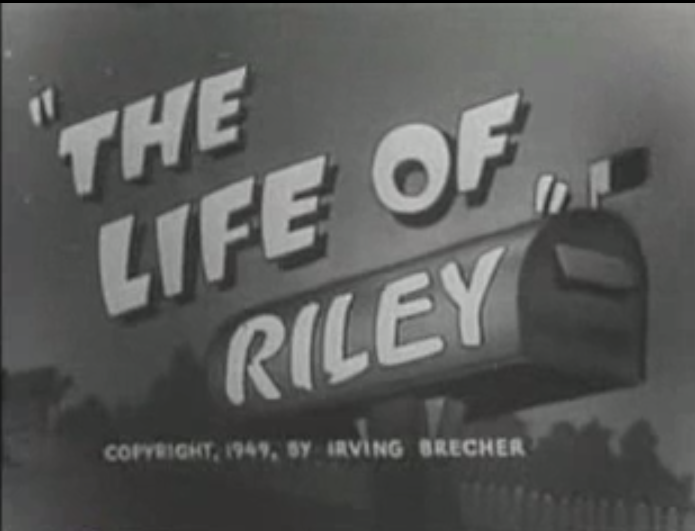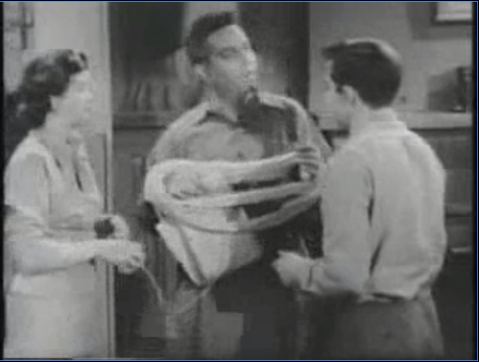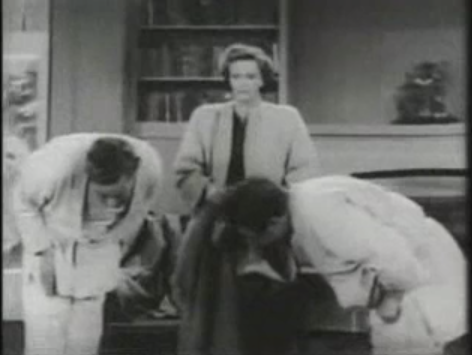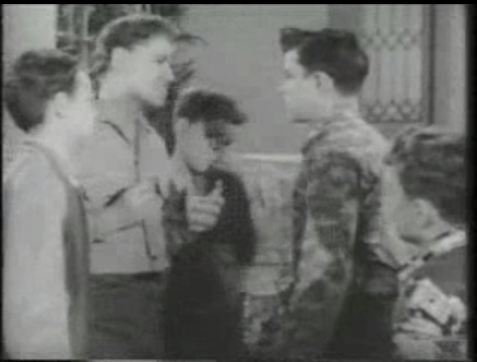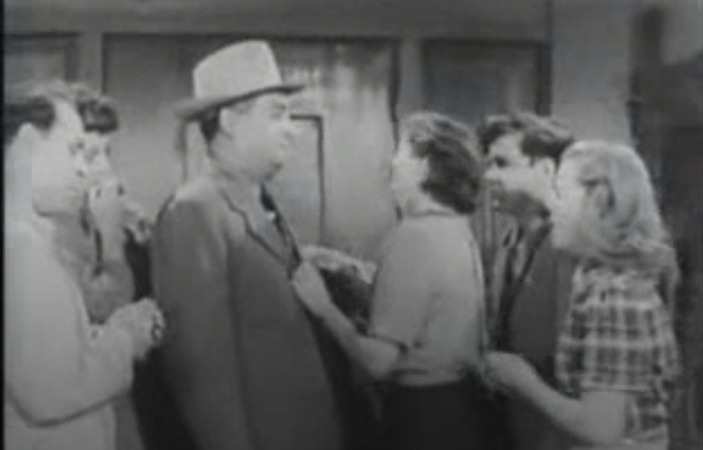What I watched: The second episode of the first season of The George Burns & Gracie Allen Show. In addition to the title duo, the series starred Bea Benadaret and Hal March. This episode featured guest appearances by Truman Smith, Bob Fosse, and Mary Ann Niles, was directed by Ralph Levy, and was written by Paul Henning, Sid Dorfman, Harvey Helm, and Willy Burns. “Gracie the Artist” aired on CBS on Thursday, October 26, 1950, and is available to watch on YouTube.
What happened: George opens the show, telling us about the huge response the first episode of the show has gotten. He jokes about the advice he got from Jack Benny and Fred Allen for working on television. He then takes us to “Beverly Hills”, where Gracie is beginning the sitcom plot by going to an art gallery. A fussy curator (Smith) talks to her about the value of art compared to the trash they show on TV. This museum apparently has the Venus de Milo, The Thinker, and Aphrodite, so apparently Gracie went all the way to Paris. She ends up alarmed at the nudity. After initially thinking she’s joking, the curator realizes that Gracie is really an idiot, and tells her to go home. Gracie hears that the art is pricelss and decides to get rich by becoming an artist.
George is back monologuing about Gracie, and how he loves her despite her ditzy ways. He then steps into the sitcom, where he receives a number of art supplies Gracie has ordered, including an “artist’s weasel.” He goes back to the archway to talk to the audience some more, and introduces he dance act Fosse and Niles while we wait for Gracie to come home. They do some brief tap dancing.
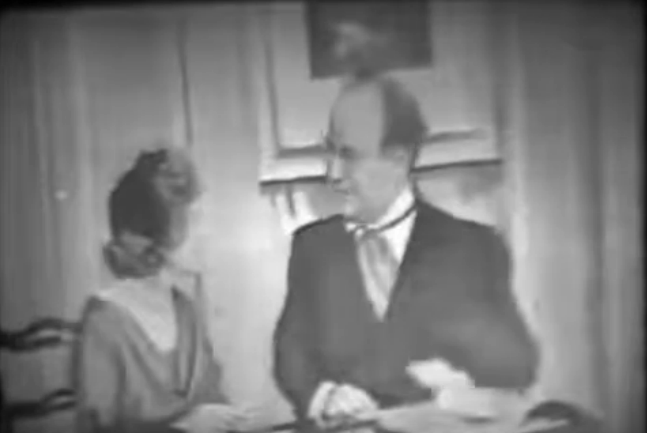
Back in the story, Gracie and George finally interact, as he reminisces about their old Vaudeville days. They do a little dance to remember the old days, occasionally interrupting to tell a joke, as per their act. We drop in on the couple’s neighbours Blanche and Harry Morton (March), whose husband keeps going on about how stupid Gracie is. Blanch defends her, but admits Gracie is a little strange.
George breaks the fourth wall some more by telling us that Blanch is played by Bea Benaderet (SP?) who doesn’t like him in or out of character. Harry comes over to find that Gracie is mixing paint in an egg beater, and has resolved to make one masterpiece a day. Sounds like some Mr. Turner stuff. George proposes that she paint Harry in the nude. Harry tells a joke about a cow, which turns into an ad for Carnation Milk.
George ends up being the one who poses for Gracie, who swears the picture is a perfect likeness. Blanch comes by and thinks it’s a picture of a cab. We don’t actually see the picture. Gracie cries at not getting the response she wants, and George promises to buy her all the clothes she wants. As it turns out, Gracie is just sad because her feet are sore, and still thinks the picture’s a masterpiece. You go girl! After another plug for milk, George and Gracie come out to say good night to the audience.
What I thought: 1950 was the year that a number of big radio stars moved to TV as part of NBC and CBS’s drive to compete with each other, and the married couple team of George Burns and Gracie Allen were among them. The duo had worked together for decades through vaudeville, film, and radio, all with the same basic act: the ditzy and absurd Gracie and the straight man George. In television, that formula would prove a success in yet another new medium.
The most immediately interesting element of the show is the way in which it blends aspects of the sitcom and the variety show. George is part of the action, but he also frequently steps outside the show to interact with the audience, breaking the fourth wall. The sitcom plot is periodically interrupted by variety-style acts as well as George’s stand-up. The transition helps to establish George as the above-it-all smart-aleck. Gracie, on the other hand, is entirely guileless, only existing in the show-within-the-show.
This makes The George Burns and Gracie Allen show an early example of the gradual transition from variety to sitcoms as the genre of choice for light entertainment, although variety would still be dominant for most of the decade. Like Your Show of Shows, it uses the structure of a live variety show as a frame for a miniature sitcom. This was only their second show on TV, and one of the few that would be broadcast from New York instead of California, so maybe the variety elements were toned down over time, but it makes for a very unique presentation.
This format perfectly suits the plot, which would be too thin to spend a full thirty minutes in. The story sees Gracie trying to become a famous artist, drawing on a few high-art references that would have been familiar to the audience (and relatively recent, in the case of Rodin) at the time. I understand why the episode chose to not show us Gracie’s apparently very hard-to-comprehend painting, but it would have been nice to see what the props department came up with. Hey, representational art was on the way out, so maybe Gracie could have been a big deal.

I have some more immediate thoughts, including whether the whole George-and-Gracie dynamic is misogynist, but this show ran for eight years, so I’ll save something in the chamber for now.
What else was on: In a sign of the new competition for eyeballs, George and Gracie were opposed by fellow star Groucho Marx, hosting You Bet Your Life. You Bet Your Life was the higher-rated show over the course of the season, finishing #17 overall, and based on seeing one episode of each I’d probably have picked it too. ABC’s game show Stop the Music, also a radio emigre, also finished ahead of Burns and Allen at #23, despite ABC’s smaller reach.
Up against this line-up, DuMont ceded the hour, having stations show local programming. In the New York hours, viewers could watch dueling local talent shows: Talent Parade on WOR and Stairway to Stardom on WATV. The latter show, which has no relation to the later public access series, was one of the first TV shows with a Black host and is sadly lost to time.
Coming up next: Kukla, Fran, and Ollie features a visit from someone named “Sweet Williams.”


